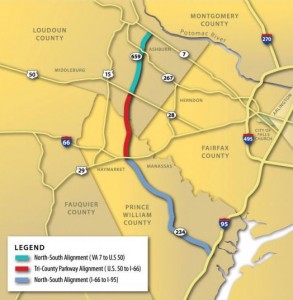The McDonnell administration has unveiled its vision for a north-south highway and other improvements to Virginia’s newest Corridor of Statewide Significance.
The McDonnell administration has unveiled a recommended alignment for a limited access highway to be built as the backbone of the North-South Corridor of Statewide Significance in Northern Virginia. The 45-mile circumferential highway would start at Interstate 95 in the south, swing west of Dulles International Airport and terminate at Route 7 in the north.
The route would following existing highways, roads and projects contained in the comprehensive plans of Prince William County and Loudoun County. In a brief presentation of the proposal yesterday to the Commonwealth Transportation Board, Deputy Secretary of Transportation David Tyeryar justified the project on the grounds that it would help Dulles airport compete in the air cargo arena and would serve an area on the fringe of metropolitan Washington whose population is expected to grow by hundreds of thousands over the next three decades.
Although Tyeryar noted that the highway would provide an estimated $3.9 million a year in annual travel-time savings, he did not tell the CTB what the facility was estimated to cost. No one on the CTB asked. However, answering questions after the presentation, Dironna Moore Belton, policy program manager for the Office of Intermodal Planning and Investment, gave a rough estimate of $1 billion to be financed by a yet-to-be-determined mix of local, state and private dollars.
The presentation inspired a sharp rebuke from Stewart Schwartz, executive director of the Coalition for Smarter Growth. “I thought it was a very thin presentation. It failed in the most basic way by not even providing a price or a detailed explanation of what they were proposing.” The cost of the circumferential highway does not include a connector to Dulles airport or proposed upgrades to Rt. 606 running along the western edge of the airport, which could add another $500 million, he said. Tyeryar provided no Return on Investment analysis, Schwartz added, nor, given Northern Virginia’s many transportation needs, did he address alternative uses of public funds.
No money has been allocated to the project, Tyeryar said. The McDonnell administration has simply laid out its vision for the corridor. Before anything gets built, the eight segments of the proposed highway need to be studied in significantly more detail and gain approvals from local governments and Northern Virginia’s regional transportation planning organization. Segments will be constructed piece-meal as money becomes available. No action from the CTB was needed yesterday.
The project has been a top priority for Gary Garczynski, Northern Virginia district representative for the CTB. “This is a blueprint for the future,” he said. “We still have challenges. We’re asking for acceptance of this study to be continued.”
In making his presentation, Tyeryar summarized the findings of the just-released “Northern Virginia North-South Corridor of Statewide Significance Corridor Master Plan.” The deputy transportation secretary, a former Prince William County budget director, has acted as the McDonnell administration’s point man on the project through a series of public presentations and official public hearings over the past several months.
The Master Plan provides a detailed description of the McDonnell administration’s vision for the corridor, which the CTB had designated as a Corridor of Statewide Significance in 2011. Key elements include: Read more.
Correction: An earlier draft of this article stated that David Tyeryar estimated that the travel-time savings from the highway would be $3.9 billion. The correct figure is $3.9 million.

